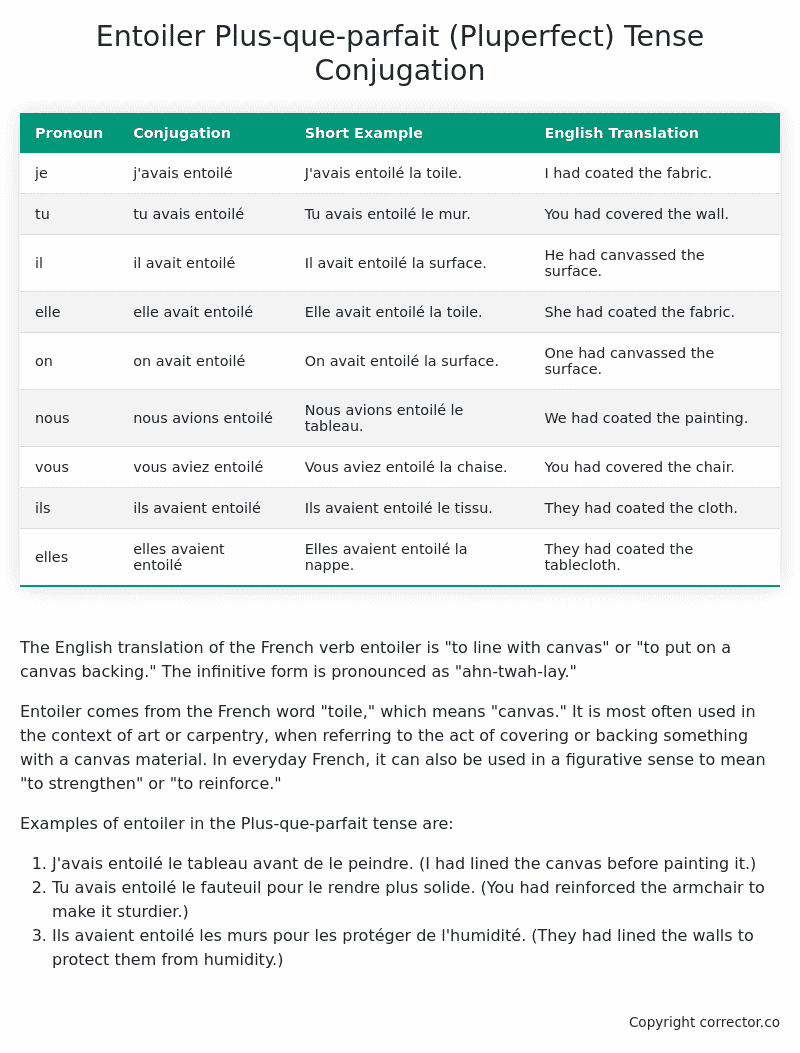Plus-que-parfait (Pluperfect) Tense Conjugation of the French Verb entoiler
Introduction to the verb entoiler
The English translation of the French verb entoiler is “to line with canvas” or “to put on a canvas backing.” The infinitive form is pronounced as “ahn-twah-lay.”
Entoiler comes from the French word “toile,” which means “canvas.” It is most often used in the context of art or carpentry, when referring to the act of covering or backing something with a canvas material. In everyday French, it can also be used in a figurative sense to mean “to strengthen” or “to reinforce.”
Examples of entoiler in the Plus-que-parfait tense are:
- J’avais entoilé le tableau avant de le peindre. (I had lined the canvas before painting it.)
- Tu avais entoilé le fauteuil pour le rendre plus solide. (You had reinforced the armchair to make it sturdier.)
- Ils avaient entoilé les murs pour les protéger de l’humidité. (They had lined the walls to protect them from humidity.)
Table of the Plus-que-parfait (Pluperfect) Tense Conjugation of entoiler
| Pronoun | Conjugation | Short Example | English Translation |
|---|---|---|---|
| je | j’avais entoilé | J’avais entoilé la toile. | I had coated the fabric. |
| tu | tu avais entoilé | Tu avais entoilé le mur. | You had covered the wall. |
| il | il avait entoilé | Il avait entoilé la surface. | He had canvassed the surface. |
| elle | elle avait entoilé | Elle avait entoilé la toile. | She had coated the fabric. |
| on | on avait entoilé | On avait entoilé la surface. | One had canvassed the surface. |
| nous | nous avions entoilé | Nous avions entoilé le tableau. | We had coated the painting. |
| vous | vous aviez entoilé | Vous aviez entoilé la chaise. | You had covered the chair. |
| ils | ils avaient entoilé | Ils avaient entoilé le tissu. | They had coated the cloth. |
| elles | elles avaient entoilé | Elles avaient entoilé la nappe. | They had coated the tablecloth. |
Other Conjugations for Entoiler.
Le Present (Present Tense) Conjugation of the French Verb entoiler
Imparfait (Imperfect) Tense Conjugation of the French Verb entoiler
Passé Simple (Simple Past) Tense Conjugation of the French Verb entoiler
Passé Composé (Present Perfect) Tense Conjugation of the French Verb entoiler
Futur Simple (Simple Future) Tense Conjugation of the French Verb entoiler
Futur Proche (Near Future) Tense Conjugation of the French Verb entoiler
Plus-que-parfait (Pluperfect) Tense Conjugation of the French Verb entoiler (this article)
Passé Antérieur (Past Anterior) Tense Conjugation of the French Verb entoiler
Futur Antérieur (Future Anterior) Tense Conjugation of the French Verb entoiler
Subjonctif Présent (Subjunctive Present) Tense Conjugation of the French Verb entoiler
Subjonctif Passé (Subjunctive Past) Tense Conjugation of the French Verb entoiler
Subjonctif Imparfait (Subjunctive Imperfect) Tense Conjugation of the French Verb entoiler
Subjonctif Plus-que-parfait (Subjunctive Pluperfect) Tense Conjugation of the French Verb entoiler
Conditionnel Présent (Conditional Present) Tense Conjugation of the French Verb entoiler
Conditionnel Passé (Conditional Past) Tense Conjugation of the French Verb entoiler
L’impératif Présent (Imperative Present) Tense Conjugation of the French Verb entoiler
L’infinitif Présent (Infinitive Present) Tense Conjugation of the French Verb entoiler
Struggling with French verbs or the language in general? Why not use our free French Grammar Checker – no registration required!
Get a FREE Download Study Sheet of this Conjugation 🔥
Simply right click the image below, click “save image” and get your free reference for the entoiler Plus-que-parfait tense conjugation!

Entoiler – About the French Plus-que-parfait (Pluperfect) Tense
Tense Formation
Common everyday usage patterns
Sequencing of past events
Background information
Hypothetical or reported speech
Interactions with other tenses
Summary
I hope you enjoyed this article on the verb entoiler. Still in a learning mood? Check out another TOTALLY random French verb conjugation!


